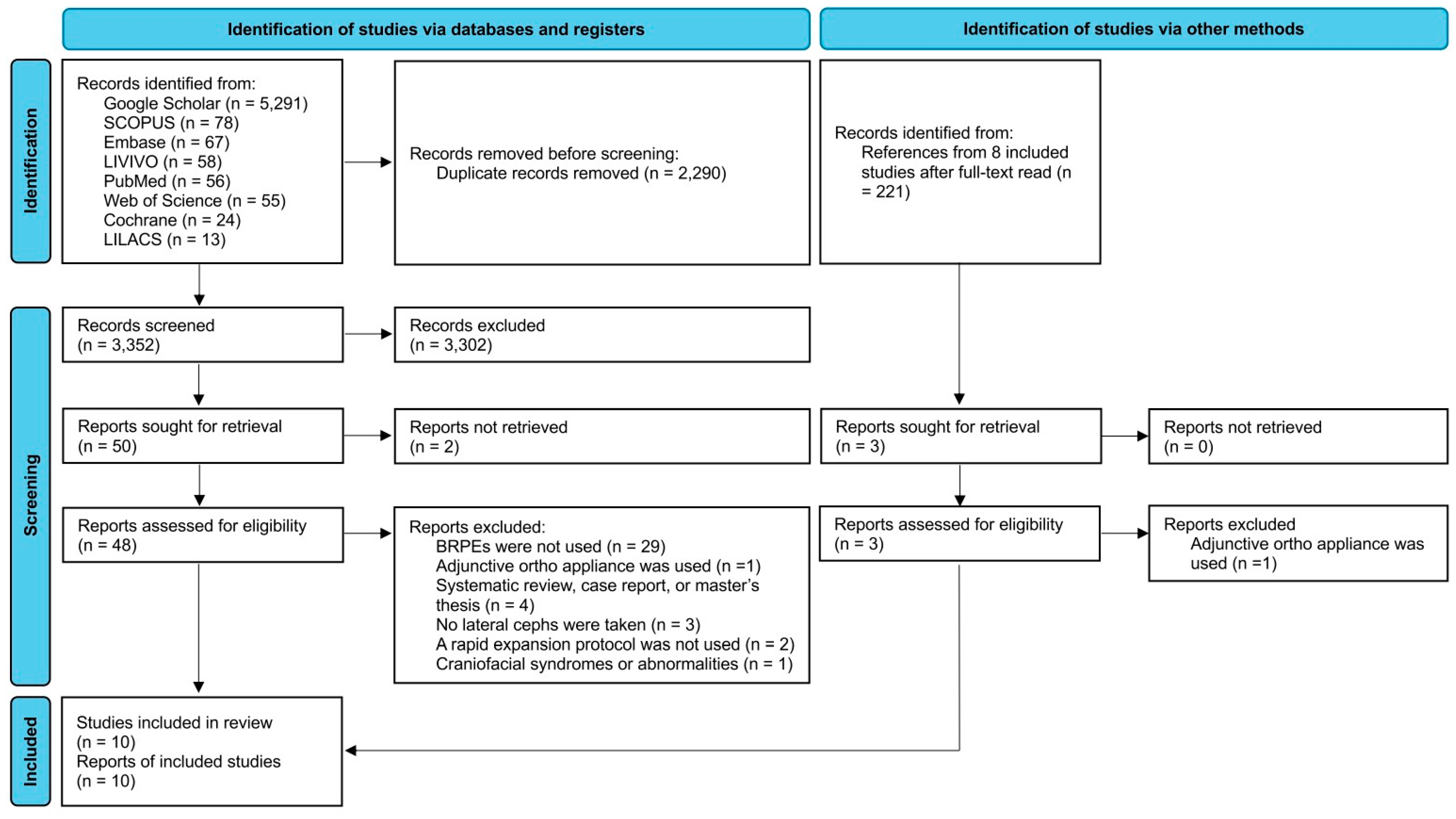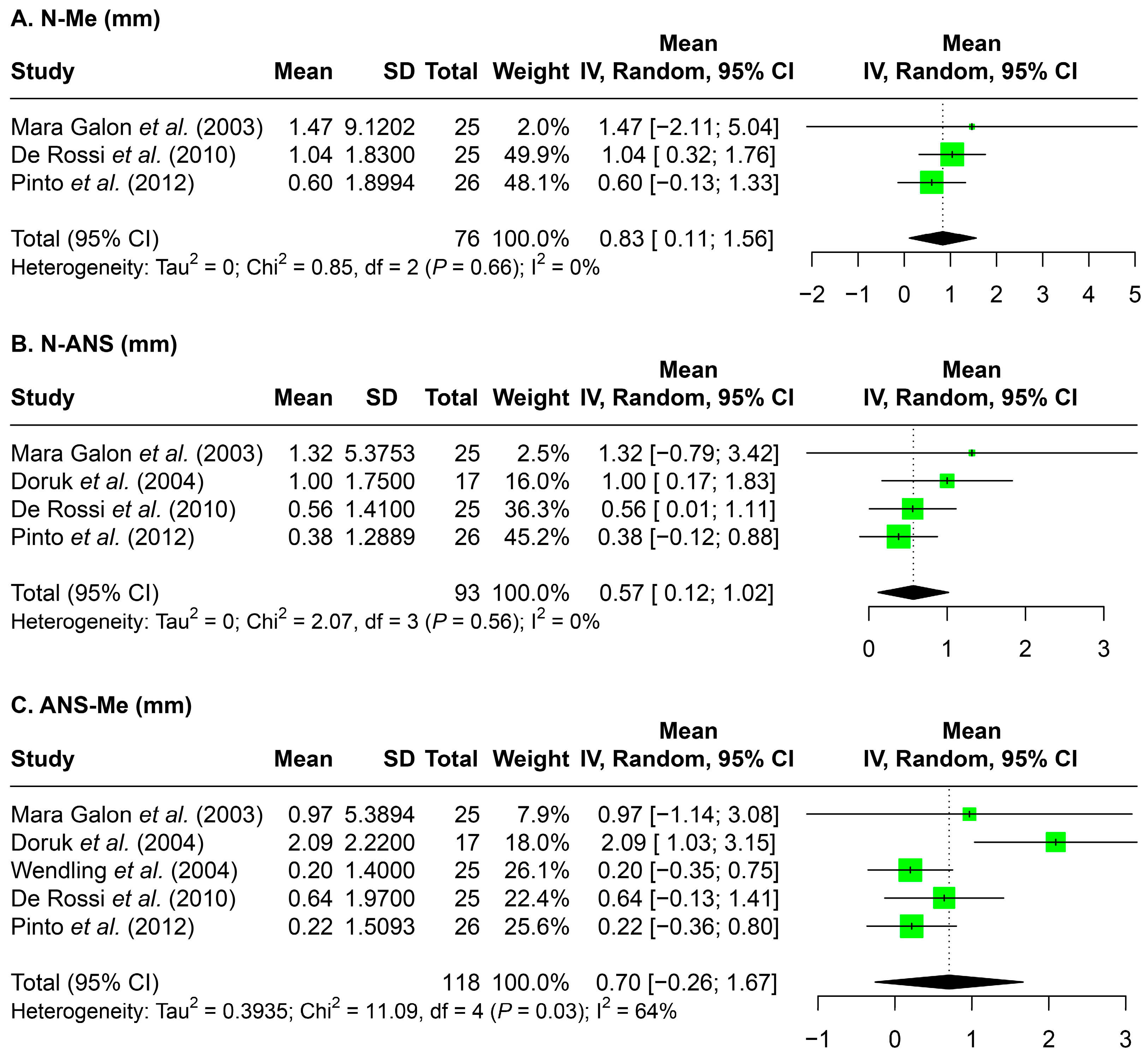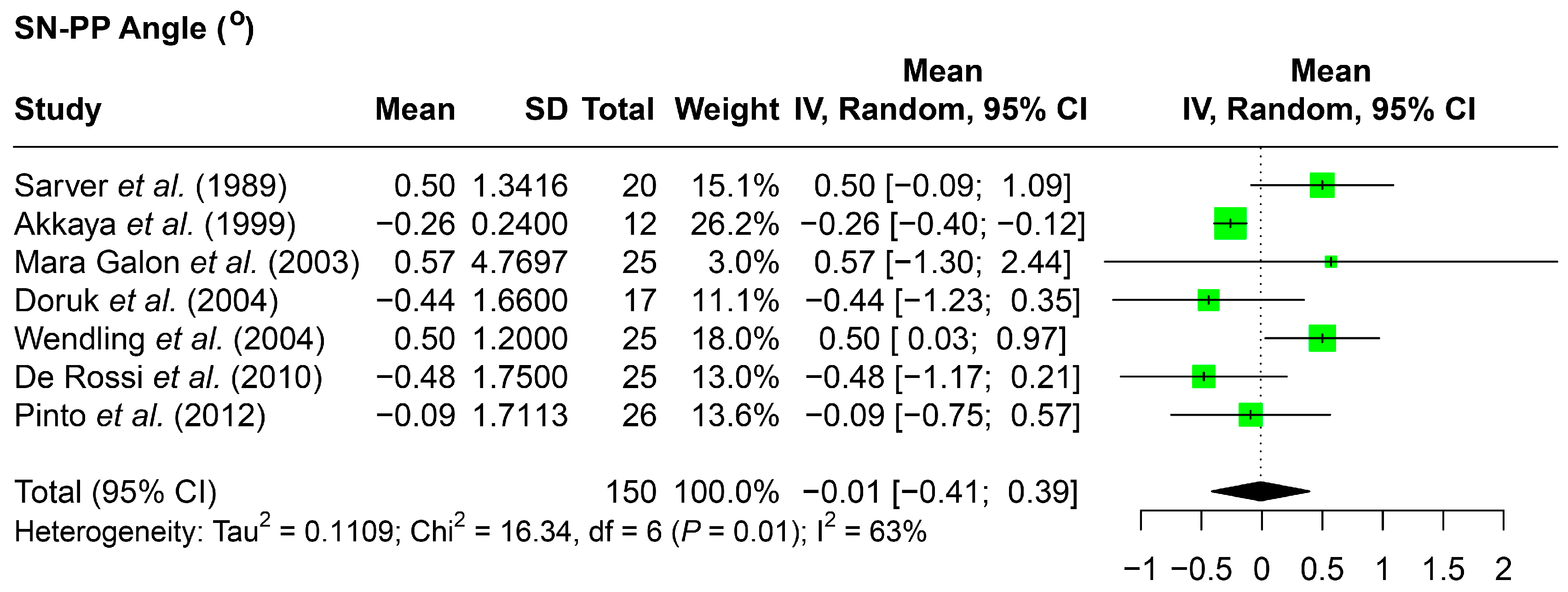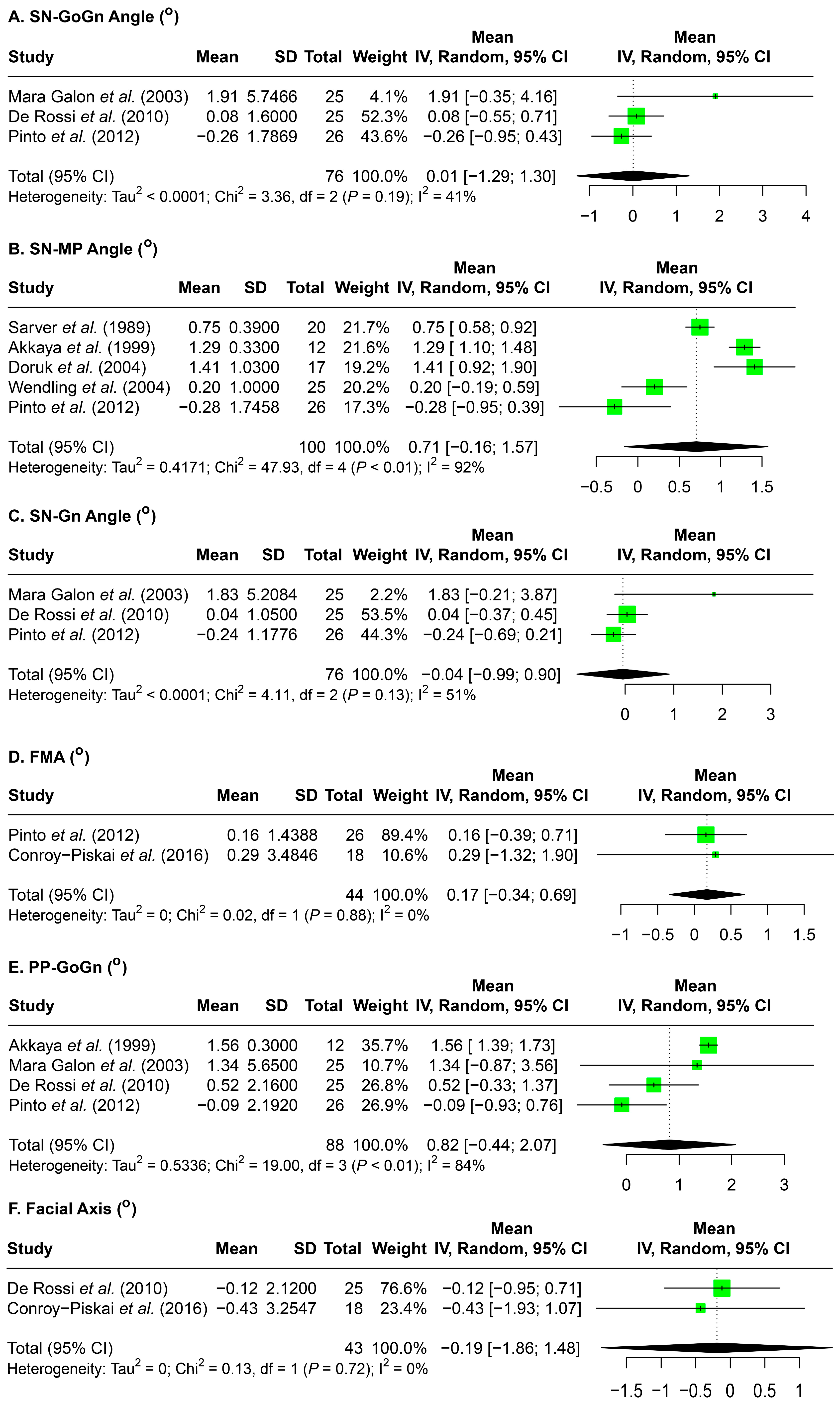Effects of Bonded Rapid Palatal Expander on Vertical Dimension: A Systematic Review and Meta-Analysis
Abstract
1. Introduction
2. Materials and Methods
2.1. Study Selection Criteria
2.2. Search Strategy
2.3. Risk of Bias/Quality Assessment
2.4. Data Extraction and Analysis
2.5. Statistical Analysis
3. Results
3.1. Literature Searching and Study Selections
3.2. Risk of Bias
3.3. Demographic Data
3.4. Facial Height
3.5. Palatal Plane Angulation and Position
3.6. Molar Position and Occlusal Plane Angulation
3.7. Skeletal Assessments of the Vertical Dimension
4. Discussion
4.1. Summary of Evidence
4.2. Limitations
5. Conclusions
Author Contributions
Funding
Institutional Review Board Statement
Informed Consent Statement
Data Availability Statement
Conflicts of Interest
References
- Hsu, J.Y.; Cheng, J.H.; Feng, S.W.; Lai, P.C.; Yoshida, N.; Chiang, P.C. Strategic treatment planning for anterior open bite: A comprehensive approach. J. Dent. Sci. 2024, 19, 1328–1337. [Google Scholar] [CrossRef] [PubMed]
- Nielsen, I.L. Vertical malocclusions: Etiology, development, diagnosis and some aspects of treatment. Angle Orthod. 1991, 61, 247–260. [Google Scholar] [PubMed]
- Chung, C.H.; Font, B. Skeletal and dental changes in the sagittal, vertical, and transverse dimensions after rapid palatal expansion. Am. J. Orthod. Dentofac. Orthop. 2004, 126, 569–575. [Google Scholar] [CrossRef] [PubMed]
- Lagravere, M.O.; Heo, G.; Major, P.W.; Flores-Mir, C. Meta-analysis of immediate changes with rapid maxillary expansion treatment. J. Am. Dent. Assoc. 2006, 137, 44–53. [Google Scholar] [CrossRef] [PubMed]
- Sarver, D.M.; Johnston, M.W. Skeletal changes in vertical and anterior displacement of the maxilla with bonded rapid palatal expansion appliances. Am. J. Orthod. Dentofac. Orthop. 1989, 95, 462–466. [Google Scholar] [CrossRef] [PubMed]
- Asanza, S.; Cisneros, G.J.; Nieberg, L.G. Comparison of Hyrax and bonded expansion appliances. Angle Orthod. 1997, 67, 15–22. [Google Scholar] [PubMed]
- Pinto, F.M.P.; Abi-Ramia, L.B.P.; Stuani, A.S.; Stuani, M.B.S.; Artese, F. Vertical growth control during maxillary expansion using a bonded Hyrax appliance. Dent. Press. J. Orthod. 2012, 17, 101–107. [Google Scholar] [CrossRef]
- Rossi, M.S.; Stuani, M.B.S.; Silva, L.A.B. Cephalometric evaluation of vertical and anteroposterior changes associated with the use of bonded rapid maxillary expansion appliance. Dent. Press. J. Orthod. 2010, 15, 62–70. [Google Scholar]
- Shen, C.; Park, T.H.; Chung, C.H.; Li, C. Molar Distalization by Clear Aligners with Sequential Distalization Protocol: A Systematic Review and Meta-Analysis. J. Funct. Biomater. 2024, 15, 137. [Google Scholar] [CrossRef] [PubMed]
- Hasan, A.K.; Tizini, M.; Haffaf, R.A. Changes of the vertical dimension after expansion using bonded acrylic splint expander a clinical study. Tishreen Univ. J. Res. Sci. Stud. 2019, 41, 293–301. [Google Scholar]
- Galon, G.M.; Calçada, F.; Ursi, W.; Vilanova Queiroz, G.; Atta, J.; Almeida, G.A. Comparacao Cefalometrica entre os Aparelhos de ERM Bandado e Colado com Recobrimento Oclusal/Cephalometric Comparative Study between the Banded and the Bonded Rapid Maxillary Expansion Appliances. Rev. Dent. Press Ortodon. Ortop. Maxilar 2003, 8, 49–59. [Google Scholar]
- Akkaya, S.; Lorenzon, S.; Ucem, T.T. A comparison of sagittal and vertical effects between bonded rapid and slow maxillary expansion procedures. Eur. J. Orthod. 1999, 21, 175–180. [Google Scholar] [CrossRef] [PubMed]
- Conroy-Piskai, C.; Galang-Boquiren, M.T.; Obrez, A.; Viana, M.G.; Oppermann, N.; Sanchez, F.; Edgren, B.; Kusnoto, B. Assessment of vertical changes during maxillary expansion using quad helix or bonded rapid maxillary expander. Angle Orthod. 2016, 86, 925–933. [Google Scholar] [CrossRef] [PubMed]
- Doruk, C.; Bicakci, A.A.; Basciftci, F.A.; Agar, U.; Babacan, H. A comparison of the effects of rapid maxillary expansion and fan-type rapid maxillary expansion on dentofacial structures. Angle Orthod. 2004, 74, 184–194. [Google Scholar] [PubMed]
- Wendling, L.K.M.J.; James, A.; Franchi, L.; Baccetti, T. A Prospective Study of the Short-term Treatment Effects of the Acrylic-splint Rapid Maxillary Expander Combined with the Lower Schwarz Appliance. Angle Orthod. 2005, 75, 7–14. [Google Scholar] [PubMed]
- Harrer, M.; Cuijpers, P.; Furukawa, T.A.; Ebert, D.D. Doing Meta-Analysis with R: A Hands-On Guide; Chapman and Hall/CRC: Boca Raton, FL, USA, 2021. [Google Scholar]
- Harrer, M.; Cuijpers, P.; Furukawa, T.; Ebert, D.D. dmetar: Companion R Package For The Guide ‘Doing Meta-Analysis in R’, R package. version 0.1.0; GitHub: Francisco, CA, USA, 2019.
- Buschang, P.H.R.; Roldan, S.I.; Tadlock, L.P. Guidelines for assessing the growth and development of orthodontic patients. Semin. Orthod. 2017, 23, 321–335. [Google Scholar] [CrossRef]
- Lione, R.; Franchi, L.; Cozza, P. Does rapid maxillary expansion induce adverse effects in growing subjects? Angle Orthod. 2013, 83, 172–182. [Google Scholar] [CrossRef] [PubMed]
- Reed, N.; Ghosh, J.; Nanda, R.S. Comparison of treatment outcomes with banded and bonded RPE appliances. Am. J. Orthod. Dentofac. Orthop. 1999, 116, 31–40. [Google Scholar] [CrossRef] [PubMed]





| Criteria | Description |
|---|---|
| Population | Growing patients with a maxillary transverse discrepancy |
| Intervention | Bonded rapid palatal expander |
| Comparisons | Pre-treatment records |
| Outcome | Change in skeletal and dentoalveolar vertical parameters |
| Akkaya et al. (1999) [12] | Asanza et al. (1997) [6] | Conroy-Piskai et al. (2016) [13] | De Rossi et al. (2010) [8] | Doruk et al. (2004) [14] | Hasan et al. (2019) [10] | Mara Galon et al. (2003) [11] | Pinto et al. (2012) [7] | Sarver et al. (1989) [5] | Wendling et al. (2005) [15] | ||
|---|---|---|---|---|---|---|---|---|---|---|---|
| Study Design | Objective: objective clearly formulated | + | + | + | + | + | + | - | + | + | + |
| Sample size: considered adequate and estimated before collection of data | ? | ? | ? | ? | ? | + | - | ? | + | + | |
| Baseline characteristics: similar baseline characteristics | + | + | + | + | - | + | - | + | - | + | |
| Co-interventions (retainer, etc.) | + | + | + | + | - | - | - | + | + | + | |
| Randomization | |||||||||||
| Random sampling | - | - | - | ? | - | ? | ? | ? | ? | - | |
| Random allocation of treatment | - | + | - | ? | - | ? | ? | ? | ? | - | |
| Study Measurements | Measurement method: appropriate to the objective | + | + | + | + | + | + | - | + | + | + |
| Blind measurement: blinding | |||||||||||
| Blinding (examiner) | - | - | - | - | - | ? | - | - | - | - | |
| Blinding (statistician) | - | - | - | - | - | ? | - | - | - | - | |
| Reliability | |||||||||||
| Reliability described? (intra-rater reliability) | + | - | + | - | + | + | ? | + | - | - | |
| Adequate level of agreement? (inter-rater reliability) | - | - | + | ? | - | ? | ? | - | - | - | |
| Statistical Analysis | Statistical analysis | ||||||||||
| Appropriate for data | ? | + | + | ? | ? | + | - | ? | ? | ? | |
| Combined subgroup analysis | ? | ? | ? | ? | ? | + | - | ? | ? | ? | |
| Cofounders (co-interventions): confounders included in analysis | - | - | - | - | - | ? | - | - | - | - | |
| Statistical significance level | |||||||||||
| p-value stated? | + | + | + | + | + | + | - | + | + | + | |
| Confidence intervals stated? | - | - | + | - | - | + | ? | - | - | - | |
| Other | Clinical significance | + | + | + | + | + | + | - | + | + | + |
| Total score | 7 | 8 | 10 | 6 | 5 | 10 | 0 | 7 | 6 | 7 | |
| Percentage of the total | 41.18 | 47.06 | 58.82 | 35.29 | 29.41 | 58.82 | 0 | 41.18 | 35.29 | 41.18 | |
| Risk of bias | MED | HIGH | MED | HIGH | MED | MED | HIGH | MED | HIGH | HIGH | |
| Study | Study Type | Mean Patient Age | Patient Age Range | Sample Size (F/M) | Expansion Protocol | Treatment Time | Time of Post-Expansion Records |
|---|---|---|---|---|---|---|---|
| Akkaya et al. (1999) [12] | Unclear | 11.96 years | 10.40–13.50 years | 12 (5/7) | 2 turns/day | 0.70–1.60 months | Immediately post expansion and at 3 months retention |
| Asanza et al. (1997) [6] | Unclear | Not specified | Not specified | Not specified | 2 turns/day | Not specified | Immediately post expansion and at 3 months retention |
| Conroy-Piskai et al. (2016) [13] | Retrospective | 102.89 ± 8.90 months | Not specified | 18 (14/4) | 2 turns/day | 12.28 ± 8.29 months | At 6 months retention |
| De Rossi et al. (2010) [8] | Unclear | 8 years 5 months | 6 years 11 months–11 years 5 months | 25 (13/12) | 1/2 turn/day | 20 days (14–26 days) | At mean of 107 days (90–124 days) |
| Doruk et al. (2004) [14] | Unclear | 12.7 ±1.1 years | Not specified | 17 (10/7) | 1/2 turn/day | 26.47 ± 2.85 days | At 90 days retention (90.4 ± 6.7 days) |
| Hasan et al. (2019) [10] | Prospective | - | 6–12 years | 18 (F/M not specified) | 1 turn/day | Not specified | At 6 months retention |
| Mara Galon et al. (2003) [11] | Prospective | - | 7.4–14.1 years | 25 (13/12) | 3 turns/day | Not specified | At 4 months retention |
| Pinto et al. (2012) [7] | Unclear | 8 years 5 months | 6 years 11 months–10 years 11 months | 26 (15/11) | 2 turns/day | Not specified | At mean of 107 days (90–124 days) |
| Sarver et al. (1989) [5] | Unclear | 10.8 years | 7.5–16 years | 20 (14/6) | 2 turns/day | Not specified | Immediately post expansion |
| Wendling et al. (2005) [15] | Prospective | 9 years 8 months | Not specified | 25 (15/10) | 1 turn/day | Mean of 9.7 months | At 5 months retention |
| Parameter | Article | T1 | T2 | T3 | T2-T1 Difference | T3-T1 Difference |
|---|---|---|---|---|---|---|
| N-ANS (mm) | De Rossi et al. (2010) [8] | 45.96 ± 2.92 | 46.52 ± 3.76 | 0.56 ± 1.41 | ||
| Doruk et al. (2004) [14] | 55.32 ± 3.25 | 56.62 ± 3.44 | 56.32 ± 3.36 | 1.30 ± 2.39 | 1.00 ± 1.75 | |
| Mara Galon et al. (2003) [11] | 47.00 ± 3.718 | 48.316 ± 3.882 | ||||
| Pinto et al. (2012) [7] | 45.6777 ± 2.8383 | 46.0577 ± 3.0975 | 0.3800 ± 1.2889 | |||
| N-Me (mm) | De Rossi et al. (2010) [8] | 106.72 ± 5.07 | 107.76 ± 5.24 | 1.04 ± 1.83 | ||
| Mara Galon et al. (2003) [11] | 107.860 ± 6.708 | 109.326 ± 6.179 | ||||
| Pinto et al. (2012) [7] | 108.5315 ± 4.8511 | 109.1273 ± 5.1055 | 0.5958 ± 1.8994 | |||
| ANS-Me (mm) | Asanza et al. (1997) [6] | 69.88 (range: 63.9 to 79.6) | 0.05 (range: −1.70 to 2.00) | |||
| De Rossi et al. (2010) [8] | 63.08 ± 4.06 | 63.72 ± 3.92 | 0.64 ± 1.97 | |||
| Doruk et al. (2004) [14] | 68.56 ± 4.63 | 71.15 ± 5.56 | 70.65 ± 5.37 | 2.59 ± 3.10 | 2.09 ± 2.22 | |
| Mara Galon et al. (2003) [11] | 62.975 ± 4.261 | 63.943 ± 3.300 | ||||
| Pinto et al. (2012) [7] | 62.8527 ± 3.7512 | 63.0704 ± 3.9912 | 0.2177 ± 1.5093 | |||
| Wendling et al. (2004) [15] | 64.7 ± 5.2 | 0.2 ± 1.4 | ||||
| PP-Po-Or (°) | Pinto et al. (2012) [7] | 4.1850 ± 2.7565 | 3.8612 ±2.7186 | −0.3238 ± 1.4011 | ||
| Condylion to gonion (mm) | Wendling et al. (2004) [15] | 50.1 ± 3.8 | 0.7 ± 1.8 | |||
| Gonion to pogonion (mm) | Wendling et al. (2004) [15] | 71.6 ± 3.6 | 0.9 ± 1.6 | |||
| Mandibular length (Co-Gn) (mm) | Wendling et al. (2004) [15] | 108.5 ± 5.6 | 1.5 ± 1.2 | |||
| Total facial height (NaBa-XiPm) (°) | Conroy-Piskai et al. (2016) [13] | 65.92 ± 2.27 | 65.84 ± 2.49 | −0.07 | ||
| Lower facial height (ANS-Xi-Pm) (°) | Conroy-Piskai et al. (2016) [13] | 48.28 ± 3.13 | 48.67 ± 3.16 | 0.38 | ||
| Bjork sum (degrees) | Hasan et al. (2019) [10] | 398.85 ± 5.09 | 399.51 ± 3.96 | |||
| Y-axis (SN-SGn) (degrees) | Hasan et al. (2019) [10] | 70.84 ± 4.6 | 71.17 ± 3.5 | |||
| PFH/AFH (%) | Hasan et al. (2019) [10] | 61.28 ± 3.4 | 60.93 ± 2.9 | |||
| UFH/LFH (%) | Hasan et al. (2019) [10] | 79.9 ± 5.1 | 79.3 ± 4.9 | |||
| SN-PP angle (°) | Asanza et al. (1997) [6] | 8.07 (range: 0 to 12.4) | 1.25 (range: 0.20 to 2.80) | |||
| De Rossi et al. (2010) [8] | 7.88 ± 3.44 | 7.40 ± 3.31 | −0.48 ± 1.75 | |||
| Doruk et al. (2004) [14] | 9.65 ± 2.66 | 8.94 ± 2.34 | 9.21 ± 2.38 | −0.71 ± 1.87 | −0.44 ± 1.66 | |
| Mara Galon et al. (2003) [11] | 8.063 ± 3.462 | 8.636 ± 3.281 | ||||
| Pinto et al. (2012) [7] | 6.8831 ± 2.7199 | 6.7908 ± 2.8008 | −0.0923 ± 1.7113 | |||
| Sarver et al. (1989) [5] | 0.50 ± 0.30 (SE) | |||||
| Wendling et al. (2004) [15] | 6.8 ± 4.2 | 0.5 ± 1.2 | ||||
| SN-PNS (mm) | Asanza et al. (1997) [6] | 44.0 (range: 41.6 to 49.4) | 0.50 (range: −1.20 to 1.50) | |||
| Sarver et al. (1989) [5] | 0.35 ± 0.18 (SE) | |||||
| SN-ANS (mm) | Asanza et al. (1997) [6] | 51.8 (range: 46.3 to 58.5) | 1.50 (range: 0.40 to 4.20) | |||
| Sarver et al. (1989) [5] | 1.25 ± 0.19 (SE) | |||||
| SN–occlusal plane angle (°) | Akkaya et al. (1999) [12] | 25.94 ± 1.19 | 26.85 ± 1.17 | 25.89 ± 0.97 | ||
| De Rossi et al. (2010) [8] | 19.24 ± 3.97 | 19.00 ± 4.67 | −0.24 ± 2.87 | |||
| Pinto et al. (2012) [7] | 20.0415 ± 4.0931 | 20.1308 ± 4.3207 | 0.0893 ± 1.5746 | |||
| Wendling et al. (2004) [15] | 20.8 ± 5.0 | −0.3 ± 3.2 | ||||
| U6-PP (mm) | Asanza et al. (1997) [6] | 22.23 (range: 17.0–26.0) | −0.90 (range: −2.50 to 0.75) | |||
| Conroy-Piskai et al. (2016) [13] | 19.62 ± 1.79 | 19.29 ± 2.07 | −0.33 | |||
| L6-MP (mm) | Conroy-Piskai et al. (2016) [13] | 26.79 ± 2.27 | 27.66 ± 2.62 | 0.87 | ||
| SN-MP angle (°) | Akkaya et al. (1999) [12] | 39.40 ± 0.84 | 41.33 ± 0.99 | 40.69 ± 0.85 | ||
| Doruk et al. (2004) [14] | 39.09 ± 7.26 | 40.94 ± 7.17 | 40.50 ± 7.18 | 1.85 ± 1.37 | 1.41 ± 1.03 | |
| Pinto et al. (2012) [7] | 39.1738 ± 5.2802 | 38.8958 ± 5.2642 | −0.2781 ± 1.7458 | |||
| Sarver et al. (1989) [5] | 0.75 ± 0.39 | |||||
| Wendling et al. (2004) [15] | 35.3 ± 6.1 | 0.2 ± 1.0 | ||||
| MP-FH angle (FMA) (°) | Conroy-Piskai et al. (2016) [13] | 29.26 ± 2.32 | 29.55 ± 2.60 | 0.29 | ||
| Pinto et al. (2012) [7] | 26.0965 ± 4.4902 | 26.2550 ± 4.5948 | 0.1585 ± 1.4388 | |||
| PP-GoGn angle (°) | De Rossi et al. (2010) [8] | 29.40 ± 4.17 | 29.92 ± 3.35 | 0.52 ± 2.16 | ||
| Mara Galon et al. (2003) [11] | 27.642 ± 3.686 | 28.983 ± 4.282 | ||||
| Pinto et al. (2012) [7] | 30.1196 ± 4.0914 | 30.0346 ± 4.1125 | −0.0850 ± 2.1920 | |||
| SN-GoGn angle (°) | De Rossi et al. (2010) [8] | 37.28 ± 5.31 | 37.36 ± 4.79 | 0.08 ± 1.60 | ||
| Mara Galon et al. (2003) [11] | 35.706 ± 3.810 | 37.613 ± 4.302 | ||||
| Pinto et al. (2012) [7] | 37.0612 ± 5.2509 | 36.8019 ± 5.2126 | −0.2593 ± 1.7869 | |||
| SN-Gn angle (°) | De Rossi et al. (2010) [8] | 68.88 ± 4.52 | 68.92 ± 4.61 | 0.04 ± 1.05 | ||
| Mara Galon et al. (2003) [11] | 67.154 ± 3.581 | 68.986 ± 3.782 | ||||
| Pinto et al. (2012) [7] | 69.0262 ± 4.5551 | 68.7873 ± 4.5124 | −0.2389 ± 1.1776 | |||
| Facial axis (NaBa-PtGn) (°) | Conroy-Piskai et al. (2016) [13] | 84.07 ± 2.22 | 83.64 ± 2.38 | −0.43 | ||
| De Rossi et al. (2010) [8] | 85.16 ± 3.28 | 85.04 ± 4.01 | −0.12 ± 2.12 |
Disclaimer/Publisher’s Note: The statements, opinions and data contained in all publications are solely those of the individual author(s) and contributor(s) and not of MDPI and/or the editor(s). MDPI and/or the editor(s) disclaim responsibility for any injury to people or property resulting from any ideas, methods, instructions or products referred to in the content. |
© 2025 by the authors. Licensee MDPI, Basel, Switzerland. This article is an open access article distributed under the terms and conditions of the Creative Commons Attribution (CC BY) license (https://creativecommons.org/licenses/by/4.0/).
Share and Cite
Horne, S.; Sung, D.; Campos, H.C.; Habeb, S.; Sfogliano, L.; Chung, C.-H.; Li, C. Effects of Bonded Rapid Palatal Expander on Vertical Dimension: A Systematic Review and Meta-Analysis. J. Clin. Med. 2025, 14, 7035. https://doi.org/10.3390/jcm14197035
Horne S, Sung D, Campos HC, Habeb S, Sfogliano L, Chung C-H, Li C. Effects of Bonded Rapid Palatal Expander on Vertical Dimension: A Systematic Review and Meta-Analysis. Journal of Clinical Medicine. 2025; 14(19):7035. https://doi.org/10.3390/jcm14197035
Chicago/Turabian StyleHorne, Sarah, Doyeon Sung, Hugo Cesar Campos, Shahd Habeb, Luca Sfogliano, Chun-Hsi Chung, and Chenshuang Li. 2025. "Effects of Bonded Rapid Palatal Expander on Vertical Dimension: A Systematic Review and Meta-Analysis" Journal of Clinical Medicine 14, no. 19: 7035. https://doi.org/10.3390/jcm14197035
APA StyleHorne, S., Sung, D., Campos, H. C., Habeb, S., Sfogliano, L., Chung, C.-H., & Li, C. (2025). Effects of Bonded Rapid Palatal Expander on Vertical Dimension: A Systematic Review and Meta-Analysis. Journal of Clinical Medicine, 14(19), 7035. https://doi.org/10.3390/jcm14197035






